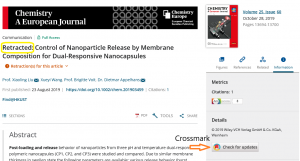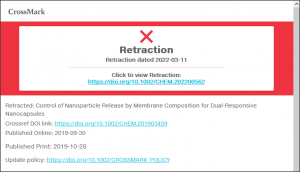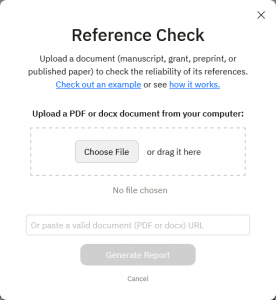You would not want to cite a retracted paper in your article or your thesis without knowing. This week we talk about how to get yourself aware of retractions, and to do a reference “health check” before you submit your writing.
Retracted Publications
Journal articles may be retracted for different reasons, such as issues in authorship or data, conflicts of interest, errors in methods or analysis, falsification, and plagiarism. The database Retraction Watch lists over 100 reasons for retraction. For example, this 2021 paper on material science was retracted by the journal editor because the authors used similar images in multiple articles with different claims, arousing questions to their integrity (Figure 1).
According to Retraction Watch Database, every month hundreds of publications receive “Expression of Concern” or are retracted. Studies found that retracted papers are still being used; many researchers continue to cite them for a long time. It is legitimate to discuss a retracted article in your work if you are aware of the retraction and the reasons behind; however, if you cite a retracted work without knowing, it may cast doubts on your research quality and integrity.
This post shows you a few simple ways to identify retraction of journal articles, and to screen your lists of references before you put them in your thesis or journal submission.
How to Find Out Retractions
How do you know if a paper is retracted? The journal publisher involved should have first-hand information. On the other hand, the Retraction Watch Database is an important source of retraction information.
Journal Websites
When a journal retracts an article, it normally issues a retraction notice (Figure 1). At the webpage of the original article, often the word “Retracted” is added to the title (Figure 2). In some journals, the fulltext of retracted papers are still available. However, some journals take down the original article page and the fulltext; and redirect the original doi to the Retraction Notice.
Adding the text “Retracted” at the title may be good enough for human readers, but it is not a smart way to communicate with machine readers. The metadata of the article should also tag retraction status. If the publisher uses CrossMark, a service by the DOI agency Crossref, you can see the information after you click the CrossMark icon (Figure 3).
Retraction Watch Database
Two scientists founded Retraction Watch, a blog that reports news on research integrity and retraction. They also created the Retraction Watch Database, which has become the most relied-upon information sources of publication retraction. A very useful feature is their index of “reasons”; you can easily see why the papers were retracted (Figure 4).
Tools to Flag Retraction in Your References
Retraction can happen at any time after publication. For example, a 1991 clinical study was retracted after 30 years, in 2022 (Figure 5). How do you make sure the literature that your research bases on does not contain retracted works? If you have to check your reference lists paper-by-paper before you cite them, it is a very tedious task. The good news is, there are tools that help you “flag” problematic references. Here we introduce two methods.
Reference Management Tools such as Zotero
Some reference management software have integrated Retraction Watch Database data to give retraction alerts in your reference lists; they include EndNote, ReadCube Papers and Zotero.
For example, in Zotero, if there is a retracted item in your references, you can see alerts in multiple places:
Scite’s Reference Checks
Scite.ai is a database that shows you citation contexts of publications. It has a function called Reference Checks, with which you can check if a list of references are cited as supported, disputed, or are retracted. You can upload your own paper to let it run through the references (Figure 7).
It generates a report, alerting you if it finds any problematic references:
Scite does not use Retraction Watch data, but relies on other data sources and their own algorithms. Therefore, we may expect that its performance in detecting and flagging retracted items would be different from tools that are based on Retraction Watch Database.
The Library subscribes to scite’s full package. HKUST members can use all the functions in scite.ai.
To learn more about tracking retracted papers, these two articles by Aaron Tay, a librarian in Singapore, are informative and interesting:
- Understanding the current state of retractions
- Checking for retractions & other quality checks on your manuscript before journal submissions
— By Gabi Wong, Library
Views: 2693
Go Back to page Top
- Category:
- Research Tools
Tags: CrossMark, retraction, Retraction Watch, scite, zotero
published April 6, 2022










